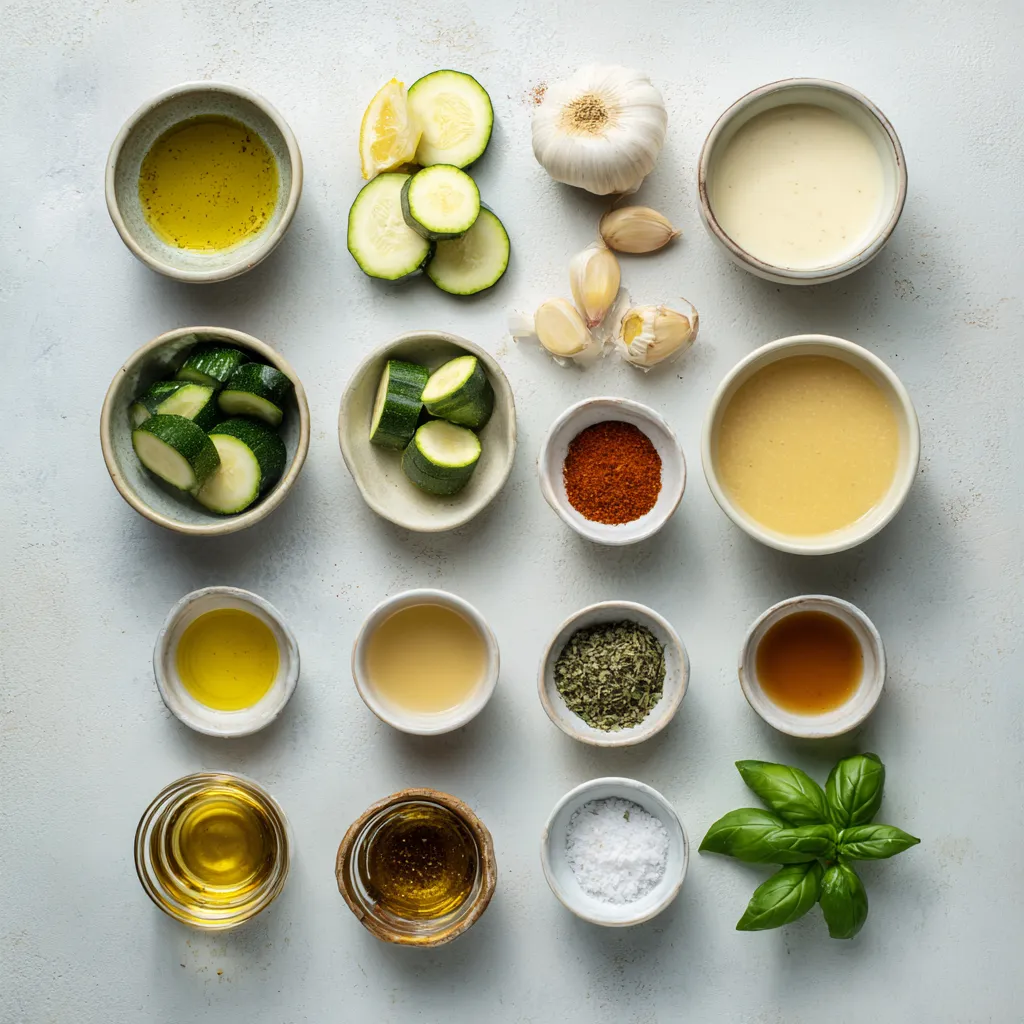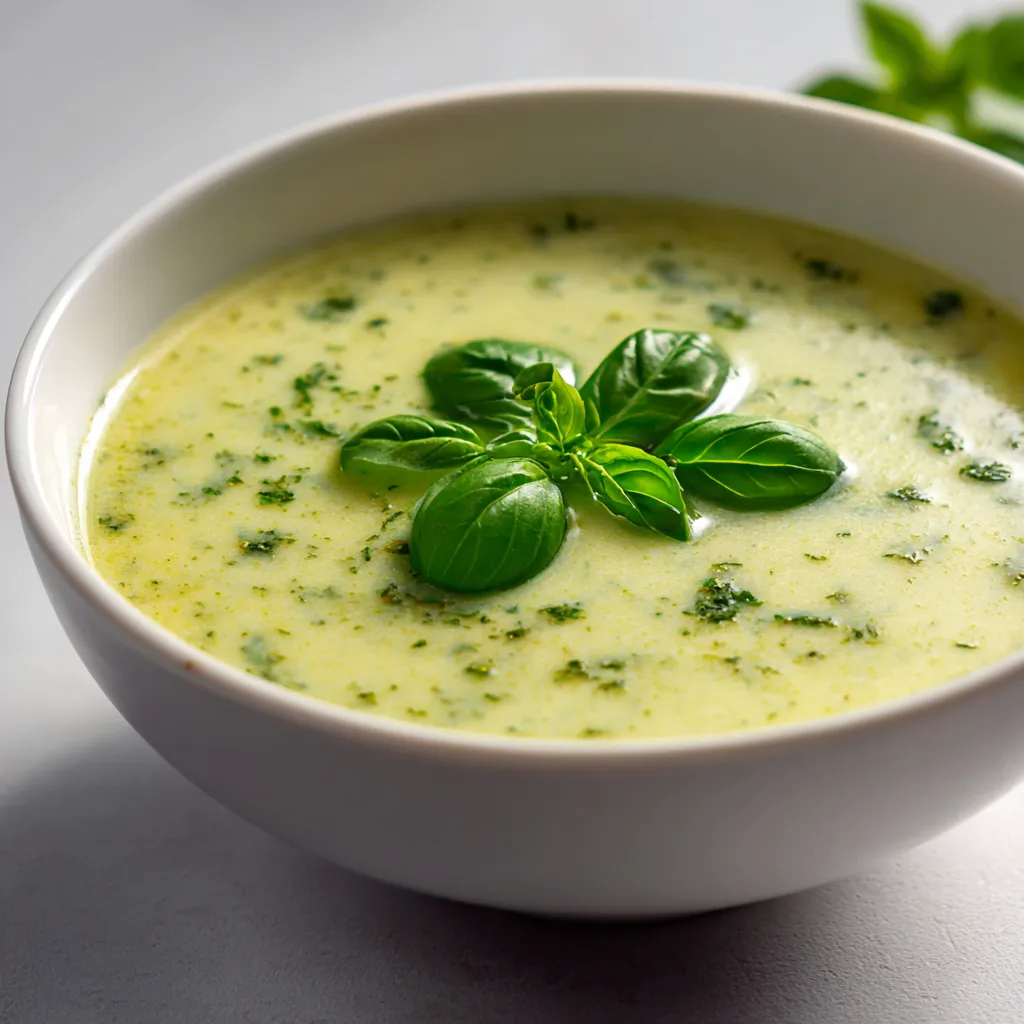Introduction
Zucchini Bliss: Creamy Crockpot Soup is a delightful dish that captures the essence of creamy textures and rich flavors in a wholesome, health-conscious manner. This soup offers a unique blend of fresh zucchini, aromatic herbs, and a touch of creaminess that will warm your heart and soothe your soul. Its vibrant green color is visually appealing, making it an inviting option for lunch or dinner.
Using fresh vegetables in soup recipes not only enhances the flavor but also elevates the nutritional profile of your meals. Zucchini, the star ingredient in this creamy soup, is packed with essential vitamins and minerals while being low in calories, making it an ideal choice for those seeking a healthy yet satisfying dish. With the addition of coconut milk—or heavy cream, for those wanting something richer—this soup delivers a luxurious mouthfeel that perfectly complements the simplicity of the ingredients.
Beyond its taste, the soup presents numerous health benefits. Zucchini is a great source of antioxidants, while garlic and onions each bring their own health-promoting properties to the table. Whether you’re serving it at family dinners or meal prepping for a productive week, Zucchini Bliss soup will be a hit any time of year.
Recipe Overview
– Total Time: 6-8 hours (cooking time)
– Yield/Servings: 4-6 servings
– Difficulty: Not specified in the recipe
This creamy soup has a deliciously subtle flavor profile, characterized by the earthiness of zucchini complemented by the aromatic sweetness of onion and garlic. The addition of smoked paprika brings a hint of smokiness, while the herbs add fresh herbal notes, creating a balanced dish that’s both satisfying and refreshing.
This soup is perfect for various occasions—served hot for a cozy family dinner, portioned out for meal prep, or even as an inviting starter for a larger feast. Its versatility makes it suitable for both casual and special gatherings, ensuring that it can easily fit into any dining experience.
Ingredients
– 4 medium zucchinis, diced into small pieces
– 1 large onion, finely chopped
– 4 cloves garlic, minced
– 2 cups vegetable broth (low-sodium preferred)
– 1 cup coconut milk (substitute with heavy cream for a richer option)
– 1 teaspoon dried thyme
– 1 teaspoon dried basil
– 1/2 teaspoon smoked paprika
– Salt and freshly ground black pepper, to taste
– 1 tablespoon extra virgin olive oil
– 1 tablespoon freshly squeezed lemon juice
– Fresh basil leaves, torn, for garnish
The ingredient list reflects the importance of fresh produce, especially zucchini, which serves as the foundation of this soup. Their nutritional benefits include vitamins A, C, and K, along with fiber, making them an excellent addition to any meal. The onion lays the groundwork for flavor, while garlic enhances it with its health benefits and incomparable aroma.
Opting for low-sodium vegetable broth ensures the soup remains healthy and light. Additionally, the choice between coconut milk and heavy cream allows for customization based on dietary requirements; both bring a creamy texture, though each offers a distinct flavor profile that can be explored. The seasoning team—thyme, basil, and smoked paprika—works harmoniously to contribute depth to this comforting dish.

Instructions
1. Prepare the Vegetables: Begin by cutting the zucchinis into bite-sized pieces. Chop the onion finely and mince the garlic to release its aromatic oils.
2. Sauté Aromatics: In a medium skillet over medium heat, pour in the olive oil. Add the chopped onion and minced garlic, sautéing for about 3-4 minutes until the mixture becomes fragrant and the onion turns translucent.
3. Combine Ingredients in the Crockpot: Transfer the sautéed onion and garlic into the crockpot. Mix in the diced zucchinis, vegetable broth, dried thyme, dried basil, smoked paprika, and season generously with salt and pepper. Stir everything together until well combined.
4. Cook the Soup: Place the lid on the crockpot and set it to cook on low for 6 to 8 hours or on high for about 3 to 4 hours, until the zucchinis are tender and easily pierced with a fork.
5. Blend the Soup: Once cooked, use an immersion blender to blend the soup until it reaches a velvety smooth consistency. If you don’t have an immersion blender, carefully transfer the soup in sections to a traditional blender, then return it to the pot.
6. Add Creaminess: Stir in the coconut milk (or heavy cream) and the lemon juice. Blend again if needed to achieve a consistently creamy texture to the soup.
7. Taste and Adjust: Sample the soup to make sure the flavors are balanced. Adjust the seasoning as preferred by adding extra salt, pepper, or lemon juice.
8. Serve and Garnish: Ladle the warm soup into bowls and finish by garnishing each serving with torn fresh basil leaves for an added pop of flavor and color. Enjoy this comforting dish!
The instructions walk you through the preparation of the vegetables, sautéing of the aromatics, combining all elements in the crockpot, and finally blending it to achieve the desired creamy consistency. Each step is critical to ensure a well-developed flavor profile and texture that is both smooth and inviting.
Preparing the Vegetables
Preparing the vegetables is an essential step in creating a wonderful flavor base for any soup, and Zucchini Bliss is no different. To begin with, cutting the zucchini into bite-sized pieces not only promotes even cooking but also ensures that the texture remains pleasing. A uniform cut will allow the zucchini to soften at the same rate, ensuring that your soup has a creamy consistency with every spoonful.
When tackling the task of dicing zucchini, it is important to use a sharp knife to make clean cuts. This helps prevent bruising and preserves the vegetable’s flavor. For those unfamiliar with dicing techniques, start by slicing the zucchini lengthwise into strips, then cut across those strips to create smaller cubes.
Chopping onions can often be a tearful endeavor; however, with a few tips, you can achieve the desired fine chop while minimizing discomfort. Use a sharp knife and cut the onion vertically, leaving the root intact until the end to reduce the release of irritating compounds. Once diced, the onion will serve as a fundamental aromatic that lays the groundwork for the soup’s flavors.
The garlic should be minced finely to release its essential oils effectively, which can enhance the overall flavor profile of the soup. Using the flat side of your knife press down on a garlic clove before chopping can help make the mincing process easier and more efficient.
Sautéing Aromatics
Sautéing aromatics is a foundational step in building flavor in any dish. In Zucchini Bliss, this process begins with heating olive oil in a medium skillet. The oil acts as a medium that carries the flavor, enhancing the overall dish. As the oil heats, it releases delicate flavors from the garlic and onion, which translates into a deeply aromatic foundation for the soup.
Recognizing when to stop sautéing is key; look signs such as softening of the onions and a slightly translucent appearance. This process usually takes about 3-4 minutes. The goal is to soften these ingredients without browning them too much, as caramelization could introduce unwanted bitter notes to the final dish. Achieving the perfect sauté involves a balance between time and temperature; maintaining medium heat will typically yield the best result while stirring occasionally.
This technique is crucial as it ensures that the onion’s sweetness and the garlic’s pungency meld together, forming a rich palate that resonates throughout the soup. Once the sautéed mixture is added to the crockpot, it infuses the entire soup with its enticing aroma and flavor, making every bowl a comforting experience that delights the senses.
Combining Ingredients in the Crockpot
Combining ingredients in the crockpot represents the transition from preparation to the cooking process, ensuring all flavors meld beautifully over time. Once the sautéed onion and garlic are in the crockpot, the addition of diced zucchini, vegetable broth, and a medley of herbs and spices creates a well-balanced flavor profile that defines this Comfort Food.
The process goes beyond simple mixing. It’s essential to take a moment to stir everything together thoroughly, ensuring that the zucchini is well-coated and engaged with the seasonings and broth. This helps distribute flavors uniformly, which is particularly important when using dried herbs like thyme and basil.
Once combined, covering the crockpot and setting it to cook allows the magic to happen. The low and slow cooking process allows the vegetables to break down, releasing their flavors while the aromas permeate the kitchen. Additionally, the slow cooking method traditionally makes the soup richer and deeper in flavor compared to faster cooking options. The result is a well-integrated dish ready to be blended into creamy deliciousness.
Through careful preparation and combining, Zucchini Bliss: Creamy Crockpot Soup becomes a wholesome, nourishing meal that is satisfyingly easy to craft and a joy to savor.

Benefits of using a crockpot for soup making
The crockpot is an invaluable tool for soup making, especially for recipes like Zucchini Bliss. By employing the slow-cooking process, flavors meld beautifully over time, resulting in a depth and richness that are challenging to achieve with other cooking methods. The gentle heat allows for the ingredients to soften without the risk of burning, ensuring that the natural sweetness of the zucchinis and onions shines through. Additionally, the crockpot allows for hands-off cooking, which means you can prepare your soup with minimal active time, freeing you up to engage in other activities while your meal simmers to perfection.
Procedure for transferring sautéed aromatics to the crockpot
Transferring the sautéed aromatics into the crockpot is pivotal for ensuring that their flavors infuse into the entire soup. After sautéing your onions and garlic until they are fragrant and translucent, use a sturdy spatula to scrape everything from the skillet into the crockpot. To capture any remnants of the aromatic goodness, consider deglazing the skillet with a splash of vegetable broth. This not only assists in flavor extraction but also makes for easier cleanup. The intention here is to make sure every bit of flavor makes its way into the soup pot.
How to layer ingredients effectively for optimal cooking
When layering ingredients in the crockpot, it’s important to manage how they cook together. Start with the cooked aromatics at the bottom, as they will benefit from the heat directly. Follow this with the diced zucchini, which will absorb the flavors during cooking. The vegetable broth should be added next to ensure even distribution of moisture. The herbs and spices can be sprinkled over the top, as this positioning allows their essential oils to escape during the lengthy cooking process, thereby maximizing flavor extraction. The strategic layering not only promotes optimal cooking but also ensures the final soup is infused with complex flavors.
Importance of seasoning at this stage
Seasoning at this stage is a critical aspect of soup-making. Salt and pepper should be added generously while mixing in the vegetables and broth, as they enhance and bring forward the natural flavors of the vegetables. Remember that seasoning can always be adjusted later, but starting with a solid foundation of flavor will set the tone for the soup. The dried thyme and basil will also release their aromatic qualities, enveloping the vegetables as they cook. A well-seasoned soup at the beginning will yield brighter and more balanced flavors when fully prepared.
Cooking the Soup
Description of cooking on low vs. high settings
Crockpots offer two primary cooking settings: low and high. Cooking on low, which typically lasts 6 to 8 hours, is ideal for developing deeper flavors. This gentle heating allows the zucchinis and other ingredients to gradually release their flavors, creating a beautifully harmonious blend. The high setting, while faster (3 to 4 hours), works well when time is limited, but it may not achieve the same profound depth of flavor. For those who prefer a softer texture, the low setting is preferred, as it breaks down the vegetables thoroughly and yields a more velvety soup.
Recommended times for cooking and signs of doneness
Cooking times are important markers for doneness. After about 3 to 4 hours on high or 6 to 8 hours on low, zucchini should be tender and easily pierced with a fork. A good sign is when the vegetables appear translucent and have a softened texture. You can also assess the soup by taste; it should be vibrant and well-seasoned. If the soup seems too watery or lacks flavor after the initial cooking, it may need an additional minute of blending or a dash of seasoning.
Advantages of slow cooking for flavors
The slow cooking method shines when it comes to flavor development in soups. As ingredients are subjected to prolonged cooking times, their flavors intermingle, producing a richer, more complex taste that is difficult to replicate in quick-cooking methods. Furthermore, the gradual breakdown of vegetables releases sugars and savory notes, enhancing the overall flavor profile. The result is a comforting bowl of soup that is both flavorful and satisfying.
Understanding the importance of a lid during cooking
Keeping the lid on the crockpot is crucial for consistent cooking. A lid traps steam and moisture, contributing to the gentle cooking environment required for achieving the desired texture and flavor. Without a lid, the moisture would evaporate, potentially leading to overcooked or dried-out ingredients. Keeping the lid secure also allows for even temperature distribution within the crockpot, ensuring that everything cooks harmoniously.
Blending the Soup
Equipment required for blending: Immersion blender vs. traditional blender
For blending the soup, both immersion and traditional blenders can be effectively used, depending on your kitchen equipment and preference. An immersion blender allows for direct blending within the crockpot, minimizing cleanup while achieving a smooth consistency. Alternatively, a traditional blender can be used for larger batches but requires careful handling to avoid splatters and spills. Whichever option you choose, ensure the soup is adequately cooled before blending to promote safety.
Tips for blending soups in batches safely
If you decide to use a traditional blender, do so in batches to prevent overflow. Fill the blender just halfway, as the hot steam produced during blending can create a hazard if the lid is not secured properly. It’s advisable to cover the lid with a towel for added protection. Blend until the soup achieves a consistently smooth texture, stopping occasionally to scrape down the sides if needed. Once blended, return the soup to the crockpot and mix before proceeding to the next stage.
How to achieve a silky-smooth texture while blending
To ensure a silky-smooth texture, blend the soup thoroughly, focusing on areas where there may still be chunks of zucchini. Consider blending in short bursts, pausing periodically to check the consistency. If the soup seems too thick after blending, feel free to add a splash of vegetable broth or coconut milk to reach your desired texture. The goal is a homogenous mix that envelops the palate.
Adding Creaminess
The role of coconut milk/heavy cream in enriching flavor
Incorporating coconut milk or heavy cream into the soup not only enriches the flavor but also contributes a luxurious creaminess that balances the fresh vegetables. Coconut milk lends a slightly sweet touch that complements the zucchini and herbs beautifully. Heavy cream, on the other hand, enhances the richness and provides a velvety mouthfeel. Both options create a delightful creaminess that enhances the soup’s overall profile.
How lemon juice balances the richness of the soup
A splash of freshly squeezed lemon juice adds brightness to the soup, counterbalancing the richness of the coconut milk or cream. The acidity from the lemon acts as a flavor enhancer, bringing forward the sweetness of the zucchinis while cutting through any heaviness. It’s a small but mighty addition that can elevate the flavor profile significantly.
Blending techniques to maintain desired consistency
To maintain the desired consistency after adding creaminess, carefully fold in the coconut milk or heavy cream. If you’ve blended the soup after adding cream, give it a quick stir or pulse to merge everything while still maintaining some body. The aim is to maintain the silky texture while allowing the natural flavors of the vegetables to shine through without losing them in the blending process.
Taste and Adjust
Importance of tasting during the cooking process
Tasting during the cooking process is vital for achieving a well-balanced soup. Adjusting flavors as you go ensures that the seasonings are in harmony, allowing for any necessary tweaks. This step can mean the difference between a mediocre soup and a standout one. Use a clean spoon to taste, and remember that flavors will meld more as the soup continues to warm.
Tips for effectively adjusting seasoning
When adjusting the seasoning, start with small increments. Add salt and pepper a little at a time, testing after each addition. If the soup seems lacking, consider incorporating additional herbs or a new dash of lemon juice. The goal is to enhance the flavors without overpowering the delicate balance already established.
Understanding how acidity from lemon juice can elevate flavors
The acidity from the lemon juice not only provides brightness but also acts as a flavor enhancer that can elevate certain notes in the soup. It can subtly lift the flavors, making the soup taste more vibrant. This contrast is especially beneficial in creamy soups, as the acidity helps balance the richness, resulting in a well-rounded final dish.
Serving and Garnishing
Best practices for ladling soup into bowls
When ladling soup into bowls, aim for an even distribution of both liquid and vegetables to ensure each serving is satisfying. Use a large ladle to avoid spills and allow for a smooth pour. Position the ladle against the edge of the bowl to control the flow, and don’t hesitate to add a few extra spoonfuls of the chunky veggie mix to create visual interest.
Garnishing with torn basil leaves: Enhancing visual appeal and flavor
Torn fresh basil leaves not only enhance the visual appeal but also add a fragrant touch that heightens the overall soup experience. The gentle oils released from the torn leaves awaken the palate, complementing the dish’s fresh flavors. Garnish just before serving, allowing the basil to retain its vibrancy and color.
Suggestions for serving accompaniments (e.g., bread or drizzles)
Consider serving your Zucchini Bliss soup with rustic bread on the side for dipping, offering a wonderful texture contrast. For an added touch, drizzle a bit of extra coconut milk or a light pour of olive oil over each bowl before serving, elevating both presentation and flavor. You might also serve it alongside a simple salad to create a more complete meal.
Optional Presentation Tips
Creative serving ideas for special occasions
For special occasions, consider presenting the soup in small cups or shot glasses as an appetizer or starter. This allows guests to enjoy the flavors in a simplified serving. Pair each serving with a small breadstick or an artisan cracker to enhance the experience.
Drizzling techniques for added elegance
When drizzling extra ingredients like olive oil or coconut milk, place the soup in the center of the bowl and lift the tool close to the surface. This technique gives a more refined, elegant appearance while creating appealing patterns on the soup’s surface.
How serving methods can enhance the dining experience
Thoughtful serving methods can elevate the overall dining experience. Offer the soup alongside fresh garnishes and options for guests to customize their flavors, such as additional herbs or spices. This interactive component adds a personal touch to each bowl and encourages engagement during the meal.
Conclusion
This Zucchini Bliss soup delivers a comforting, creamy, and flavorful experience suitable for a variety of settings. The careful blending of aromatics, fresh ingredients, and herbs creates a harmonious dish with a luxurious texture. With a cooking time of 6-8 hours, the gradual melding of flavors results in a delightful offering that is both nourishing and satisfying.


